Great Ways Music Can Help Children With ADHD
Music can be a powerful tool for emotional and physical development in children.
Making music offers opportunities to improve communication. Our child can express emotion through the noises that they make, and we can practice back and forth exchanges, turn-taking and listening skills by making sounds together.
Using musical instruments can be beneficial physically, improving breathing and fine and gross motor skills. Playing some instruments – for example a drum – offers beneficial proprioceptive feedback.
Music can also help regulate the nervous system. Slow, soft music and sounds are calming and can ease anxiety, while loud, up-tempo music is alerting, which helps an under-stimulated nervous system.
Our child may have emotional responses to certain pieces of music, which can help them develop emotional literacy. They can use it as a tool to help them self-regulate, calm down or express anger or excitement.
Dancing to music is also really fun, and particularly useful to children with ADHD who need to move and burn energy.
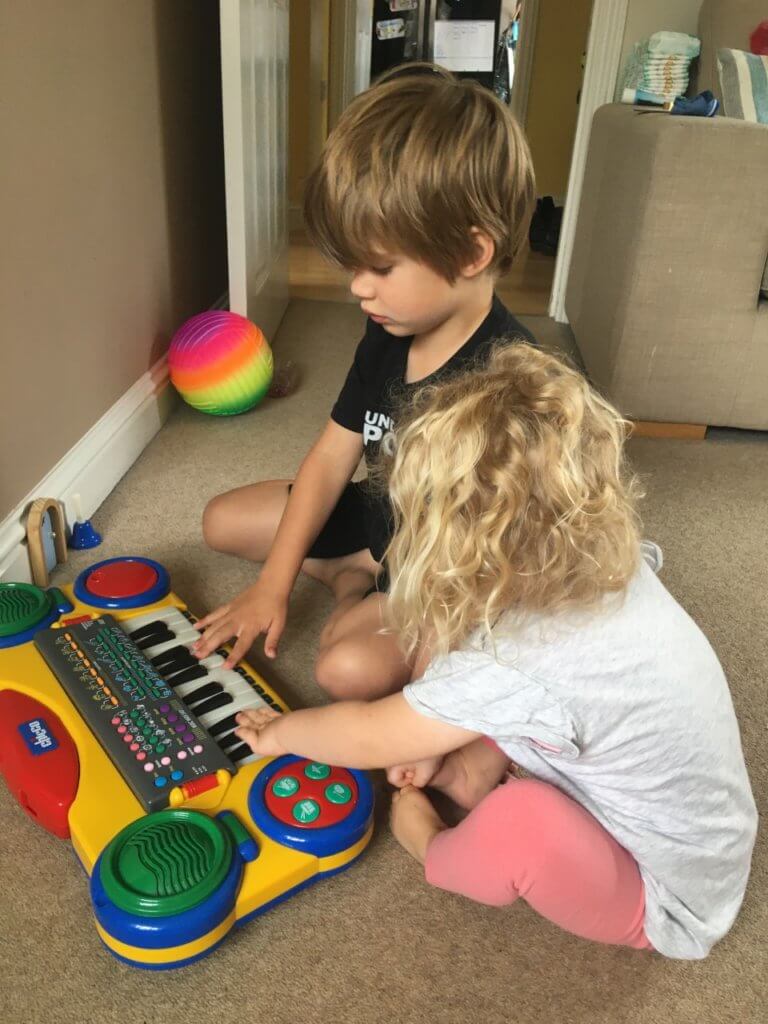
Musical Ideas to try at Home
Musical instruments are great to play with. They’re accessible, interactive, offer immediate cause and effect feedback, and most children enjoy making noise! We don’t need to be skilled in playing an instrument to enjoy the sounds we create from using it.

If we don’t have any instruments at home we can make our own using everyday objects. A wooden spoon and some upside down saucepans can become a drumkit, and a plastic bottle with some rice in it makes a great shaker. Check out this blog post for some other easy DIY instrument ideas.
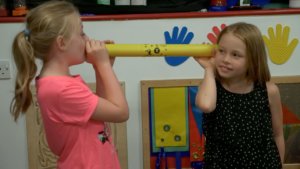
Blowing works the mouth and shoulder stability muscles to help develop breathing control. Taking deep breaths can also help to slow the heart rate and can be used to teach children how to calm themselves when becoming anxious or irritable. Mindfulness, yoga, pilates and relaxation approaches all use breath control as a means of control and self- regulation.
Blowing a whistle, harmonica, recorder or party blower are fun (and noisy!) ways to start developing breath control, and offer brilliant cause and effect feedback. Brass and wind instruments offer even more resistance.
If we don’t have these instruments available at home (or want a break from the noise!), blowing through a straw offers similar development opportunities. We can make a game out of it to make it fun for our child. Can they blow paper shapes or cotton wall across the table, or take us on at a game of blow football? Can they blow into some soft therapy putty hard enough to create a bubble? How about bubble painting? Blow into a basin of washing up liquid/bubble bath to make lots of bubbles; make it more visually exciting by adding food colouring or paint to the mix. Then paint with the bubbles!
Moving slowly and with care over accuracy and pace can be helpful for children with high activity levels. Some children tend to rush tasks because they have difficulty planning the sequences and steps. Learning to think and move with attention to steps and sequences helps to build greater awareness of their own bodies and also the executive functions needed for self-control, planning and organisation in later years.
Teach them to warm up and cool down after physical exercise – having a play list of slower music may help with this and might be fun to create together.
Dancing is an active, expressive way for our children to increase their appreciation of music. Our children often focus better when using more than one sensory system, so listening and moving at the same time can be really beneficial.
Just Dance Kids is a great game where children can enjoy learning dance routines to well known songs. You don’t need a gaming system to enjoy the Just Dance experience – there are plenty of videos on YouTube children can dance along to. Repetition can be key with these. Find one song that your child especially likes, and help them learn the movements. Over time your child may learn the routine so well they can anticipate the next move, which can rewarding and enjoyable. If that isn’t motivating, they can of course just freestyle too! You can make Just Dance part of your day-to-day routine as a way of getting a daily workout in for your child (and maybe you too!).
Flamingo Chicks have produced an amazing series of inclusive dance videos, with Makaton signing and adaptations for different needs and with a different theme for each session. This Inclusive Space Dance Class is a great example of their work. Do visit their YouTube channel for more.
We also love this series of bite-sized creative dance sessions from Wriggle Dance Theatre. The instructions are clear and children are given plenty of opportunity to be creative.
-
Sing most of a very familiar song or rhyme but don’t sing specific words or replace them with an action. This exercise is excellent to help gain control over impulsivity- simple but effective!
-
Learning song lyrics and dance routines is helpful to develop working memory, which many youngsters who have ADHD struggle with. This can also help with “social currency” among friends for tweens and teens.
5 Great Musical Apps to Try
We have found five great musical apps that you can download for your child.
-
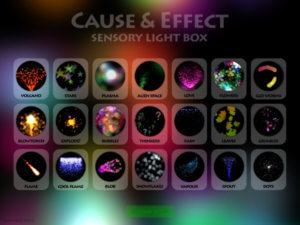 Sensory Soundbox (£2.99 – Apple). Just a touch on the screen produces a wide variety of sounds and noises. As you move your fingers across the screen, the noises change. App can be calming or stimulating, depending on the setting and offers wonderful cause and effect feedback.
Sensory Soundbox (£2.99 – Apple). Just a touch on the screen produces a wide variety of sounds and noises. As you move your fingers across the screen, the noises change. App can be calming or stimulating, depending on the setting and offers wonderful cause and effect feedback. -
Baby’s Musical Hands (free – Apple/Android). A colourful musical app – any touch will play a piano sound.
-
Finger paint (free – Apple/Android). Paint with different colours and sounds.
-
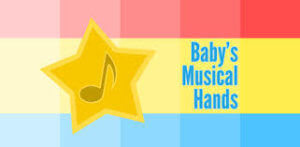 Baby Mozart (free – Apple/Android). Plays different relaxing music including instrumental, nursery rhymes and white noise. Also includes some funny noises and flashcards too.
Baby Mozart (free – Apple/Android). Plays different relaxing music including instrumental, nursery rhymes and white noise. Also includes some funny noises and flashcards too. -
Musical Me! (free – Apple). Several simple music games aimed at young children with early developing pointing finger control.
